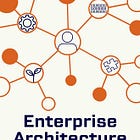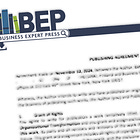Coming Soon: Enterprise Architecture – Your Guide to Organizational Transformation
Comprehensive, practical handbook for enterprise architects, leaders, and students
📅 Mark your calendars: October 14th is the official release date of my upcoming book.
When I started out in enterprise architecture (EA), I was frustrated. Most material was either too abstract, too detailed, or too fragmented. I wanted something practical that connects the dots and supports real work.
This book is my answer to that gap: practical, clear, and useful. No buzzwords, no ivory-tower theory—just real tools and advice for leading change through EA.
At the same time, I wanted it to be as comprehensive as possible. Many EA books go deep into one or two narrow topics (such as frameworks), but skip the rest. This one aims to give you the whole picture at a practical level—from making the case for EA to sustaining it over time. Think of it as a one-stop guide you can actually apply in your daily work.
And because EA without visuals is just talk, the book includes a lot of modeling examples. I use ArchiMate throughout—not only because I’m a fan of it, but because it really does work in practice. You’ll find diagrams for capabilities, layered process views, application maps, and more, all grounded in realistic use cases.
It’s also not a book just for EA professionals. I wrote it with a broader audience in mind: IT and business leaders, IT professionals, and even students who want to understand how organizations actually work and change.
Why? Because EA isn’t only about architects—it’s about creating a shared perspective that helps different roles work together. Whether you’re leading strategy, building technology, or learning the basics, you’ll benefit from seeing the bigger picture.
Why This Book?
Too many EA books dive deep into frameworks or notations and leave the rest out. This one is different: it covers all the essentials at a practical level, with examples you can actually use—whether you’re an architect, leader, or student.
What’s Inside the Book?
To give you a sense of scope, here’s a guided tour of the chapters. Each one builds on the last, moving from foundations through practical application to long-term sustainability.
Forewords
The book opens with two forewords, including one by Marc Lankhorst—one of the most recognized and influential voices in EA.
Prologue: Change With and Without EA
The prologue presents two concrete scenarios: a project manager tasked with delivering a complex solution, without EA support and with it. The contrast is clear—struggling from scratch versus moving ahead with structure and direction. It sets the stage for why EA can make such a difference.
Chapter 1: Why Should You Care About EA?
This chapter sets the stage by showing why organizations need EA in the first place. It explains how EA acts as a “map and compass” for navigating complexity, helping leaders prioritize initiatives, avoid waste, and translate strategy into actionable, coordinated change. It also names well-known organizations that apply the EA approach.
Chapter 2: What EA Really Is
This chapter is about untangling the term EA itself. I explain its different facets—governance, content, usage—and give a short history of how the practice of EA has developed globally. The aim: a clear baseline so everyone knows what we’re talking about.
Chapter 3: Where EA Creates Value
EA doesn’t exist in a vacuum. This chapter shows how EA connects to other organizational functions such as strategic planning, IT service management, solution delivery, and operations. I walk through common use contexts with examples and highlight what conditions need to be in place for EA to succeed.
Chapter 4: Making the Case for EA
Convincing leadership about EA’s value is often the hardest step. Here I share strategies and arguments for building support, from showing tangible benefits to framing EA as a management tool rather than overhead.
Chapter 5: Content That Matters
What should you actually model? Application maps, capability models, data flows, layered diagrams, principles, target states—I show how to choose the right level of detail, how to avoid over-modeling, and how to keep content alive and useful. ArchiMate examples illustrate each type of content in practice.
Chapter 6: Getting Started with EA Work
This is the “playbook” for initiating EA in an organization: defining goals, roles, stakeholders, and practices. I also touch on the often-overlooked challenge of measurement: how to show EA is creating value.
Chapter 7: Tools That Help (and Those That Don’t)
Can you run EA with PowerPoint? Sometimes. But if you want continuity, you need more. I outline what EA tools should do, what to avoid, and how to implement them without turning your repository into a dumping ground.
Chapter 8: Skills and Mindset for Enterprise Architects
What makes a good enterprise architect? Beyond frameworks and models, it’s about mindset: facilitation, communication, and continuous learning. I also look at how to recruit enterprise architects and when using external EA consultants makes sense.
Chapter 9: Sustaining EA Over Time
EA is not a one-off project. This chapter discusses how to ensure continuity: keeping practices alive, maintaining stakeholder interest, and avoiding “shelfware” content.
Chapter 10: The Future of EA
In the last chapter, I take out the crystal ball. How will AI, automation, and changing ways of working shape EA? Will we still need enterprise architects ten years from now? My take may surprise you.
📖 Learn More & Preorder
Enterprise Architecture: Your Guide to Organizational Transformation will be published on October 14th.
You can preorder the book from the publisher, Amazon, or a local bookstore.
Learn more on the landing page.
🔗 You May Also Like
Looking to dive deeper? Here are more enterprise architecture insights you might find useful:
📬 Want More Practical Enterprise Architecture Content?
Subscribe to Enterprise Architecture Transformation for real-world advice on architecture that supports change, strategy, and delivery.




